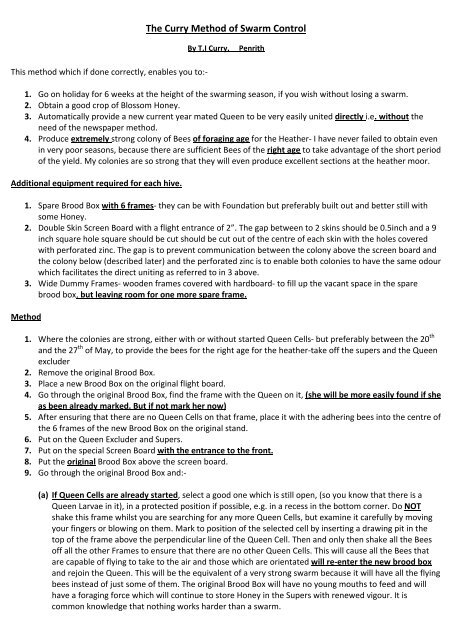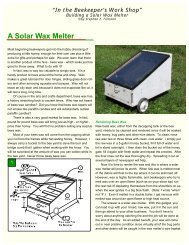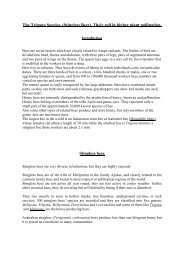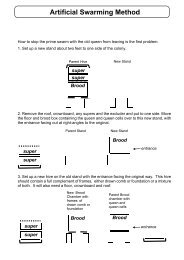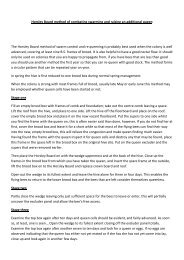Create successful ePaper yourself
Turn your PDF publications into a flip-book with our unique Google optimized e-Paper software.
<strong>The</strong> <strong>Curry</strong> <strong>Method</strong> <strong>of</strong> <strong>Swarm</strong> <strong>Control</strong><br />
By T.I <strong>Curry</strong>,<br />
Penrith<br />
This method which if done correctly, enables you to:‐<br />
1. Go on holiday for 6 weeks at the height <strong>of</strong> the swarming season, if you wish without losing a swarm.<br />
2. Obtain a good crop <strong>of</strong> Blossom Honey.<br />
3. Automatically provide a new current year mated Queen to be very easily united directly i.e. without the<br />
need <strong>of</strong> the newspaper method.<br />
4. Produce extremely strong colony <strong>of</strong> Bees <strong>of</strong> foraging age for the Heather‐ I have never failed to obtain even<br />
in very poor seasons, because there are sufficient Bees <strong>of</strong> the right age to take advantage <strong>of</strong> the short period<br />
<strong>of</strong> the yield. My colonies are so strong that they will even produce excellent sections at the heather moor.<br />
Additional equipment required for each hive.<br />
1. Spare Brood Box with 6 frames‐ they can be with Foundation but preferably built out and better still with<br />
some Honey.<br />
2. Double Skin Screen Board with a flight entrance <strong>of</strong> 2”. <strong>The</strong> gap between to 2 skins should be 0.5inch and a 9<br />
inch square hole square should be cut should be cut out <strong>of</strong> the centre <strong>of</strong> each skin with the holes covered<br />
with perforated zinc. <strong>The</strong> gap is to prevent communication between the colony above the screen board and<br />
the colony below (described later) and the perforated zinc is to enable both colonies to have the same odour<br />
which facilitates the direct uniting as referred to in 3 above.<br />
3. Wide Dummy Frames‐ wooden frames covered with hardboard‐ to fill up the vacant space in the spare<br />
brood box, but leaving room for one more spare frame.<br />
<strong>Method</strong><br />
1. Where the colonies are strong, either with or without started Queen Cells‐ but preferably between the 20 th<br />
and the 27 th <strong>of</strong> May, to provide the bees for the right age for the heather‐take <strong>of</strong>f the supers and the Queen<br />
excluder<br />
2. Remove the original Brood Box.<br />
3. Place a new Brood Box on the original flight board.<br />
4. Go through the original Brood Box, find the frame with the Queen on it, (she will be more easily found if she<br />
as been already marked. But if not mark her now)<br />
5. After ensuring that there are no Queen Cells on that frame, place it with the adhering bees into the centre <strong>of</strong><br />
the 6 frames <strong>of</strong> the new Brood Box on the original stand.<br />
6. Put on the Queen Excluder and Supers.<br />
7. Put on the special Screen Board with the entrance to the front.<br />
8. Put the original Brood Box above the screen board.<br />
9. Go through the original Brood Box and:‐<br />
(a) If Queen Cells are already started, select a good one which is still open, (so you know that there is a<br />
Queen Larvae in it), in a protected position if possible, e.g. in a recess in the bottom corner. Do NOT<br />
shake this frame whilst you are searching for any more Queen Cells, but examine it carefully by moving<br />
your fingers or blowing on them. Mark to position <strong>of</strong> the selected cell by inserting a drawing pit in the<br />
top <strong>of</strong> the frame above the perpendicular line <strong>of</strong> the Queen Cell. <strong>The</strong>n and only then shake all the Bees<br />
<strong>of</strong>f all the other Frames to ensure that there are no other Queen Cells. This will cause all the Bees that<br />
are capable <strong>of</strong> flying to take to the air and those which are orientated will re‐enter the new brood box<br />
and rejoin the Queen. This will be the equivalent <strong>of</strong> a very strong swarm because it will have all the flying<br />
bees instead <strong>of</strong> just some <strong>of</strong> them. <strong>The</strong> original Brood Box will have no young mouths to feed and will<br />
have a foraging force which will continue to store Honey in the Supers with renewed vigour. It is<br />
common knowledge that nothing works harder than a swarm.
(b) If there are no Queen Cells started, proceed exactly as above with the exception that (1) there will be no<br />
Queen Cell to be marked with a drawing pin on top <strong>of</strong> the frame. (2) Shake the bees <strong>of</strong>f all <strong>of</strong> the Frames<br />
when looking carefully for queen cells.<br />
10. 6 or 7 days later – NO MORE go through the top box carefully.<br />
(a) Check to see if the Queen Cell marked with a drawing pin as described in 9(a) is sealed and undamaged,<br />
and then carefully destroy any other Queen Cells on that Frame. (DO NOT SHAKE IT).<strong>The</strong>n shake all the<br />
bees <strong>of</strong>f all the other Frames and destroy any Queen Cells on these frames.<br />
(11)<br />
(b) If there were no Queen Cells found as describes in 9(b), carefully examine all Frames before shaking any<br />
<strong>of</strong> them and select a good Queen Cell, which is still open and mark its position with a drawing pin on the<br />
top <strong>of</strong> the Frame. Do not shake this Frame but remove the Bees with the fingers or blowing on them to<br />
enable you to find and destroy any other Queen Cells. (NB) <strong>The</strong> reason for selecting a Queen Cell which is<br />
still open is because the Queen Cells are not sealed until the 8 th day which means that if it is still open on<br />
the 6 th or 7 th day it will have had the full Queen treatment from its very early stages‐ Queen Cells which<br />
are already sealed on the 6 th or 7 th day must have been started from eggs are larva more that 2 days old<br />
and would make inferior Queens.<br />
(c) Now shake all the bees <strong>of</strong>f the remaining frames and destroy all other Queen Cells. <strong>The</strong>re cannot (if you<br />
have done all the foregoing efficiently) any eggs or larvae young enough for further viable Queen Cells<br />
to be made, so you can go on holiday for 6 weeks if you wish and your swarm control is over for another<br />
season. No more weekly inspections which are a waste <strong>of</strong> time in any case if you happen to miss a Queen<br />
Cell., that is unless you are checking for Varroa and carrying out Integrated Pest <strong>Control</strong> (IPC) but if you<br />
check for Varroa with the use <strong>of</strong> a open mesh floor and a catching drawer and the count is low you need<br />
not go into the Hive. Regular inspections only stresses your bees and (your neighbours) and also<br />
interrupts Honey gathering.<br />
(1) At least 3 or 4 days before going to the Heather, go through the top Brood Box to ensure that the<br />
new Queen is laying intact. If not already marked as described above, mark her NOW so that she<br />
can be easily found when repeating the system next year or if you need to indentify her at some<br />
later stage or in spring next year to see if she is present or if she as been superseded or lost over the<br />
winter etc.<br />
(2) Take <strong>of</strong>f the Top Brood Box, Supers and Queen Excluder.<br />
(3) Go through the bottom box and destroy any Queen Cells (I have never found any). Remove the<br />
wide Dummy Boards.<br />
(4) Give away or destroy the old Queen (essential) you will now appreciate why she should be<br />
marked in the earlier paragraph No 4. Remove all Frames not containing Brood Larvae or Eggs and<br />
keep covered to prevent robbing. <strong>The</strong>se with similar Frames from the top box will provide the<br />
Frames as suggested earlier in No 1. Leave this Brood Box in position on the floor and put all the<br />
remaining Frames in it to the side <strong>of</strong> the box.<br />
(5) Go through the former Top Brood Box and remove all Frames not containing Brood, Larvae or<br />
Eggs,(making sure not to remove the New Queen) I play it safe by placing on a Frame in a separate<br />
closed box when finding her as described in 11(1) above. You can also use a Queen Cage to keep her<br />
on the Frame but be careful not to damage her. Keep them covered to avoid robbing.<br />
(6) Put at least 2 Frames <strong>of</strong> Brood, Larvae and Eggs directly into the Brood Box on the floor, followed<br />
by the frame with the new Queen and Bees, followed by more frames <strong>of</strong> Bees , Eggs and Larvae from<br />
the Top Box. This ensures that the new Queen is surrounded initially by her own <strong>of</strong>fspring.<br />
(7) Shake or brush in (with a Goose Feather if available) the Bees from the empty Brood Box.<br />
(8) Put on the Queen Excluder and Heather Supers if going to the Heather or blossom Supers for<br />
finishing. <strong>The</strong>se Supers will need to have plenty <strong>of</strong> room in them for the larger quantity <strong>of</strong> bees from<br />
2 laying Queens.


